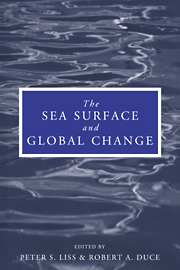Book contents
- Frontmatter
- Contents
- List of contributors
- Preface
- 1 Report Group 1 – Physical processes in the microlayer and the air–sea exchange of trace gases
- 2 Report Group 2 – Biological effects of chemical and radiative change in the sea surface
- 3 Report Group 3 – Photochemistry in the sea-surface microlayer
- 4 Transport processes in the sea-surface microlayer
- 5 The role of organic films in air–sea gas exchange
- 6 Bubbles and their role in gas exchange
- 7 The physical chemistry of air–sea gas exchange
- 8 The sea-surface microlayer and its effect on global air–sea gas transfer
- 9 Chemistry of the sea-surface microlayer
- 10 Biophysics of the surface film of aquatic ecosystems
- 11 Biological effects of chemicals in the sea-surface microlayer
- 12 Neuston of seas and oceans
- 13 Photochemistry in the sea-surface microlayer
- 14 Hydrocarbon breakdown in the sea-surface microlayer
- 15 Applications of laser technology and laser spectroscopy in studies of the ocean microlayer
- 16 Remote sensing of the sea-surface microlayer
- Index
2 - Report Group 2 – Biological effects of chemical and radiative change in the sea surface
Published online by Cambridge University Press: 24 September 2009
- Frontmatter
- Contents
- List of contributors
- Preface
- 1 Report Group 1 – Physical processes in the microlayer and the air–sea exchange of trace gases
- 2 Report Group 2 – Biological effects of chemical and radiative change in the sea surface
- 3 Report Group 3 – Photochemistry in the sea-surface microlayer
- 4 Transport processes in the sea-surface microlayer
- 5 The role of organic films in air–sea gas exchange
- 6 Bubbles and their role in gas exchange
- 7 The physical chemistry of air–sea gas exchange
- 8 The sea-surface microlayer and its effect on global air–sea gas transfer
- 9 Chemistry of the sea-surface microlayer
- 10 Biophysics of the surface film of aquatic ecosystems
- 11 Biological effects of chemicals in the sea-surface microlayer
- 12 Neuston of seas and oceans
- 13 Photochemistry in the sea-surface microlayer
- 14 Hydrocarbon breakdown in the sea-surface microlayer
- 15 Applications of laser technology and laser spectroscopy in studies of the ocean microlayer
- 16 Remote sensing of the sea-surface microlayer
- Index
Summary
Introduction
The physics, chemistry and biology of the sea surface are closely interrelated. Plankton in the water column produce an abundance of particulate and dissolved organic material, some of which is transported to the surface either passively by floatation or actively by bubble transport. Atmospheric deposition also enriches the sea surface with natural and anthropogenic compounds, which often accumulate there in relatively high concentrations compared with those in the water column. The abundance of organic matter at the sea surface provides a substrate for the growth of organisms that inhabit the sea surface microlayer: the neuston. Most studies suggest that the sea surface represents a highly productive, metabolically active interface. Organisms from most major divisions of the plant and animal kingdoms either live, reproduce or feed in the surface layers. Of particular interest are the microneuston, which may be involved in biogeochemical cycling, and neustonic eggs and larvae of commercially important fish and shellfish.
The quantities and types of anthropogenic chemicals entering the earth's atmosphere continue to grow. Many of these chemicals, some of which are highly toxic, are now globally distributed in the atmosphere and deposit to the sea surface even in remote areas. Due to stratospheric ozone depletion, ultraviolet-b (UV-B) radiation reaching the sea surface is increasing annually.
- Type
- Chapter
- Information
- The Sea Surface and Global Change , pp. 35 - 70Publisher: Cambridge University PressPrint publication year: 1997
- 4
- Cited by



